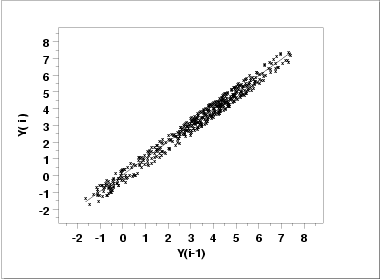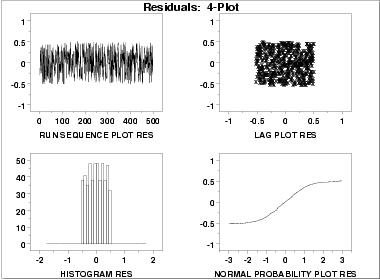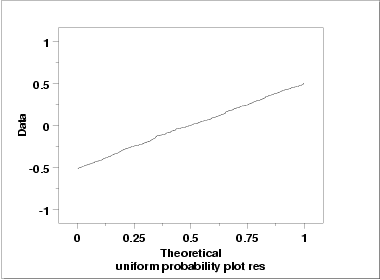1.
Exploratory Data Analysis
1.4.
EDA Case Studies
1.4.2.
Case Studies
1.4.2.3.
Random Walk
1.4.2.3.4.
|
Validate New Model
|
|
|
Plot Predicted with Original Data
|
The first step in
verifying the model
is to plot the predicted values from the fit with the original data.

This plot indicates a reasonably good fit.
|
|
Test Underlying Assumptions on the Residuals
|
In addition to the plot of the predicted values,
the residual standard deviation from the fit also indicates a
significant improvement for the model. The next step is to validate
the underlying assumptions for the error component, or
residuals, from
this model.
|
|
4-Plot of Residuals
|

|
|
Interpretation
|
The assumptions are addressed by the graphics shown above:
- The run sequence plot
(upper left) indicates no significant
shifts in location or scale over time.
- The lag plot
(upper right) exhibits a random appearance.
- The histogram
shows a relatively flat appearance. This indicates that a
uniform probability distribution may be an appropriate model
for the error component (or residuals).
- The normal probability
plot clearly shows that the normal
distribution is not an appropriate model for the error
component.
A uniform probability plot can be used to further test the
suggestion that a uniform distribution might be a good model
for the error component.
|
|
Uniform Probability Plot of Residuals
|

Since the uniform probability
plot is nearly linear, this
verifies that a uniform distribution is a good model for the error
component.
|
|
Conclusions
|
Since the residuals from our model satisfy the underlying
assumptions, we conlude that
\( Y_{i} = 0.0502 + 0.987*Y_{i-1} + E_{i} \)
where the Ei follow a uniform distribution
is a good model for this data set. We could simplify this model to
\( Y_{i} = 1.0*Y_{i-1} + E_{i} \)
This has the advantage of simplicity (the current point is simply
the previous point plus a uniformly distributed error term).
|
|
Using Scientific and Engineering Knowledge
|
In this case, the above model makes sense based on our definition
of the random walk. That is, a random walk is the cumulative sum
of uniformly distributed data points. It makes sense that modeling
the current point as the previous point plus a uniformly distributed
error term is about as good as we can do. Although this case
is a bit artificial in that we knew how the data were constructed,
it is common and desirable to use scientific and engineering knowledge
of the process that generated the data in
formulating and testing models for the data. Quite often, several
competing models will produce nearly equivalent mathematical
results. In this case, selecting the model that best approximates
the scientific understanding of the process is a reasonable choice.
|
|
Time Series Model
|
This model is an example of a time series model. More extensive
discussion of time series is given in the
Process Monitoring
chapter.
|




